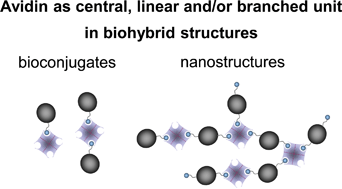In this study, Voit, Appelhans and co-workers demonstrated the successful fabrication of biohybrid structures tailored by non-covalent interactions for potential biochemical applications. Using avidin-biotin conjugation as the deciding non-covalent interaction step, different nanometer-sized biohybrid structures can be established by using different molar interaction ratios between mono-, bi- and tetravalent biotinylated glycodendrimers and avidin. The biotin ligand’s spacer length, its chemical structure and the degree of biotin functionalization were shown to be essential parameters in the formation of nanostructures with avidin having a controlled composition and size dimension up to 100 nm. Biohybrid structures with avidin as a central unit required monovalent glycodendrimers with PEG-linked biotin, while bi- and tetravalent glycodendrimers with short alkyl-linked biotin ligands were more efficient than their counterparts with longer PEG–biotin ligands in the fabrication of defined biohybrid structures (diameters up to 100 nm) with avidin as a bridging unit. Not only does this study elucidate the formation of biohybrid structures between avidin and biotinylated glycodendrimers in the conjugation solution, but it also provides deeper insight into these supramolecular (bio)polymeric structures from a general point of view.
Biohybrid structures consisting of biotinylated glycodendrimers and proteins: influence of the biotin ligand’s number and chemical nature on the biotin–avidin conjugation by Franka Ennen, Susanne Boye, Albena Lederer, Mihaela Cernescu, Hartmut Komber, Bernhard Brutschy, Brigitte Voit and Dietmar Appelhans Polym. Chem. 2014, 5, 1323-1339.
Julien Nicolas is a web-writer and advisory board member for Polymer Chemistry. He currently works at Univ. Paris-Sud (FR) as a CNRS researcher.











